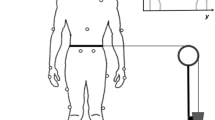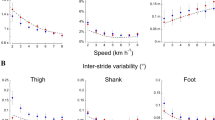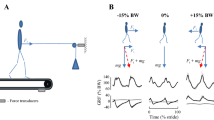Abstract
Tripping during gait occurs frequently. A successful balance recovery implies that the forward body rotation is sufficiently reduced. In view of this, adequate control of the trunk momentum is important, as the trunk has a high inertia. The aim of this study was to establish out-of-plane trunk movements after a trip and to determine trunk muscle responses. Ten male volunteers repeatedly walked over a platform in which 21 obstacles were hidden. Each subject was tripped over one of these obstacles at mid-swing of the left foot in at least five trials. Kinematics, dynamics, and muscle activity of the main trunk muscles were measured. After a trip, an increase in trunk flexion was observed (peak flexion 37°). In addition, considerable movements outside the sagittal plane (up to 20°) occurred. Already before landing of the blocked foot, the trunk forward bending movement was reduced, while trunk torsion and lateral rotation were still increasing. Fast responses were seen in both abdominal and back muscles, indicating stiffening of the trunk. These muscle responses preceded the mechanical trunk disturbances, which implies that these responses were triggered by other mechanisms (such as afferent signals from the extremities) rather than a simple stretch reflex. A second burst of predominantly trunk muscle extensor activity was seen at landing, suggesting specific anticipation of the trunk muscles to minimize trunk movements due to landing. In conclusion, despite large movements outside the sagittal plane, it appears that trunk muscle responses to trips are aspecific and especially aimed at minimizing trunk forward bending.




Similar content being viewed by others
References
Allum JH, Bloem BR, Carpenter MG, Hulliger M, Hadders-Algra M (1998) Proprioceptive control of posture: a review of new concepts. Gait Posture 8:214–242
Allum JH, Carpenter MG, Honegger F, Adkin AL, Bloem BR (2002) Age-dependent variations in the directional sensitivity of balance corrections and compensatory arm movements in man. J Physiol 542:643–663
Berg WP, Allessio HM, Mills EM, Tong C (1997) Circumstances and consequences of falls in the independent community-dwelling older adults. Age Aging 26:261–268
van der Burg JCE, van Dieën JH, Toussaint HM (2000) Lifting an unexpectedly heavy object: the effects on low-back loading and balance loss. Clin Biomech 15:469–477
van der Burg JCE, Kingma I, van Dieën JH (2003) Effects of unexpected lateral mass distribution in lifting on trunk movement and trunk loading. Spine 28:764–770
Carpenter MG, Allum JH, Honegger F (1999) Directional sensitivity of stretch reflexes and balance corrections for normal subjects in the roll and pitch planes. Exp Brain Res 129:93–113
Clancy EA, Morin EL, Merletti R (2002) Sampling, noise-reduction and amplitude estimation issues in surface electromyography. J Electromyogr Kinesiol 12:1–16
van Dieen JH, de Looze MP (1999) Directionality of anticipatory activation of trunk muscles in a lifting task depends on load knowledge. Exp Brain Res 128:397–404
Eng JJ, Winter DA, Patla AE (1994) Strategies for recovery from a trip in early and late swing during human walking. Exp Brain Res 102:339–349
Grabiner MD, Koh TJ, Lundin TM, Jahnigen DW (1993) Kinematics of recovery from a stumble. J Gerontol 48:M97–M102
Grabiner MD, Feuerbach JW, Jahnigen DW (1996) Measures of paraspinal muscle performance do not predict initial trunk kinematics after tripping. J Biomech 29:735–744
Gruneberg C, Bloem BR, Honegger F, Allum JH (2004) The influence of artificially increased hip and trunk stiffness on balance control in man. Exp Brain Res 157:472–485
Hodges PW, Cresswell AG, Daggfeldt K, Thorstensson A (2000) Three dimensional preparatory trunk motion precedes asymmetrical upper limb movement. Gait Posture 11:92–101
Hodges PW, Cresswell AG, Thorstensson A (2001) Perturbed upper limb movements cause short-latency postural responses in trunk muscles. Exp Brain Res 138:243–250
Hof AL, Gazendam MG, Sinke WE (2005) The condition for dynamic stability. J Biomech 38:1–8
Horstmann GA, Dietz V (1988) The contribution of vestibular input to the stabilization of human posture: a new experimental approach. Neurosci Lett 95:179–184
Krajcarski SR, Potvin JR, Chiang J (1999) The in vivo dynamic response of the spine to perturbations causing rapid flexion: effects of pre-load and step input magnitude. Clin Biomech 14:54–62
Maki BE, McIlroy WE (1996) Postural control in the older adult. Clin Geriatr Med 12:635
McGill SM (1991) Electromyographic activity of the abdominal and low back musculature during the generation of isometric and dynamic axial trunk torque: implications for lumbar mechanics. J Orthop Res 9:91–103
Murphy SL (2000) Deaths: final data for 1998. National Center for Health Statistics, Hyattsville MD
Nevitt MC, Cummings SR (1993) Type of fall and risk of hip and wrist fractures: the study of osteoporotic fractures. The Study of Osteoporotic Fractures Research Group. J Am Geriatr Soc 41:1226–1234
Pavol MJ, Owings TM, Foley KT, Grabiner MD (1999) Gait characteristics as risk factors for falling from trips induced in older adults. J Gerontol A Biol Sci Med Sci 54:M583–M590
Pijnappels M, Bobbert MF, van Dieen JH (2001) Changes in walking pattern caused by the possibility of a tripping reaction. Gait Posture 14:11–18
Pijnappels M, Bobbert MF, van Dieen JH (2004) Contribution of the support limb in control of angular momentum after tripping. J Biomech 37:1811–1818
Pijnappels M, Bobbert MF, van Dieën JH (2005) How early reactions in the support limb contribute to balance recovery after tripping. J Biomech 38:627–634
Schillings AM, Van Wezel BM, Duysens J (1996) Mechanically induced stumbling during human treadmill walking. J Neurosci Methods 67:11–17
Schillings AM, van Wezel BM, Mulder T, Duysens J (2000) Muscular responses and movement strategies during stumbling over obstacles. J Neurophysiol 83:2093–2102
Staude G, Wolf W (1999) Objective motor response onset detection in surface myoelectric signals. Med Eng Phys 21:449–467
Stel VS, Smit JH, Pluijm SM, Lips P (2003) Balance and mobility performance as treatable risk factors for recurrent falling in older persons. J Clin Epidemiol 56:659–668
Tang PF, Woollacott MH (1998) Inefficient postural responses to unexpected slips during walking in older adults. J Gerontol A Biol Sci Med Sci 53:M471–M480
Tang PF, Woollacott MH, Chong RK (1998) Control of reactive balance adjustments in perturbed human walking: roles of proximal and distal postural muscle activity. Exp Brain Res 119:141–152
Thomas JS, Lavender SA, Corcos DM, Andersson GBJ (1998) Trunk kinematics and trunk muscle activity during a rapidly applied load. J Electromyogr Kinesiol 8:215–225
Tinetti ME, Speechley M, Ginter SF (1988) Risk factors for falls among elderly persons living in the community. N Engl J Med 319:1701–1707
Winter DA (1995) Human balance and posture control during standing and walking. Gait Posture 3:193–214
Author information
Authors and Affiliations
Corresponding author
Rights and permissions
About this article
Cite this article
van der Burg, J.C.E., Pijnappels, M. & van Dieën, J.H. Out-of-plane trunk movements and trunk muscle activity after a trip during walking. Exp Brain Res 165, 407–412 (2005). https://doi.org/10.1007/s00221-005-2312-z
Received:
Accepted:
Published:
Issue Date:
DOI: https://doi.org/10.1007/s00221-005-2312-z




